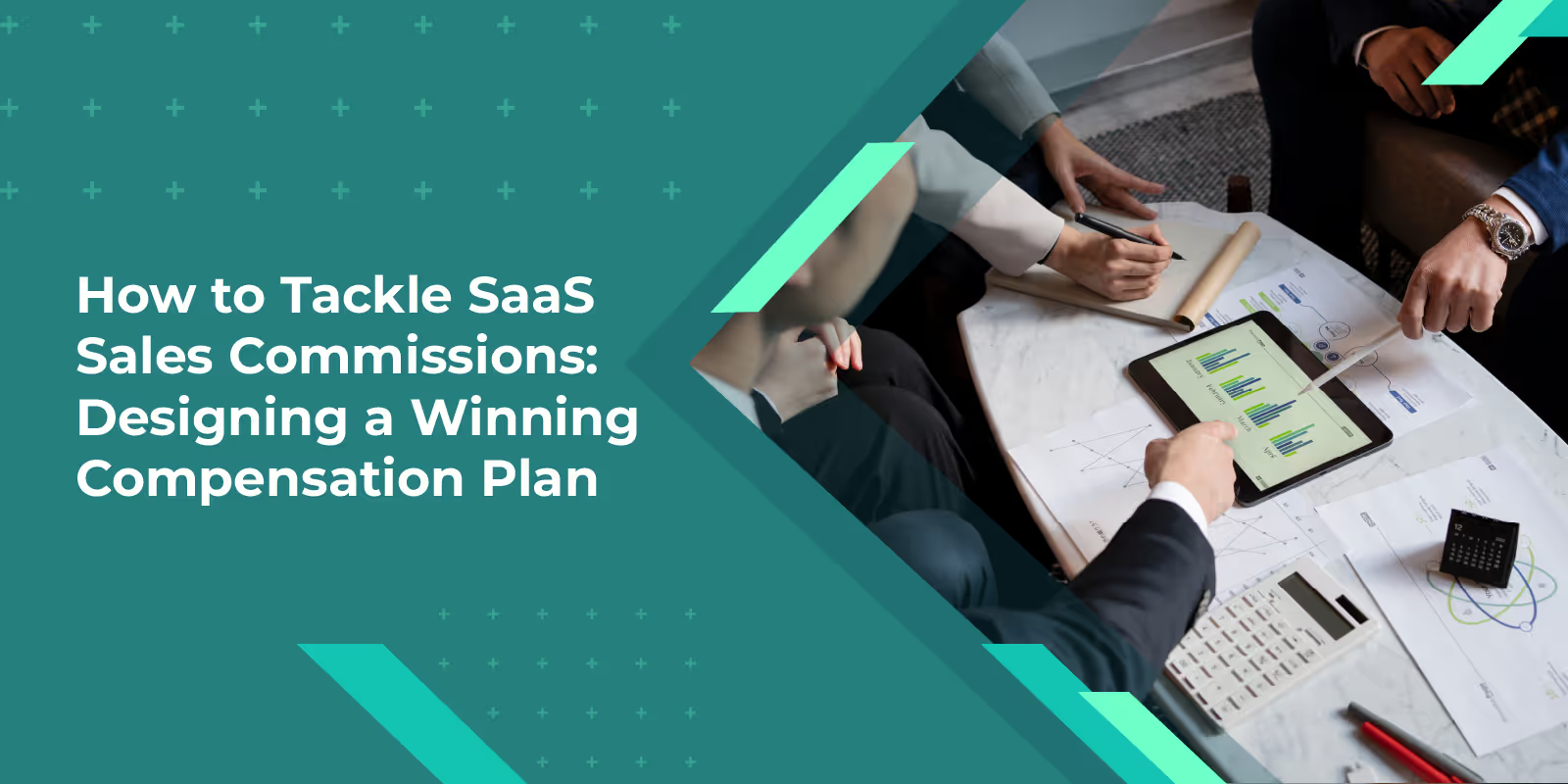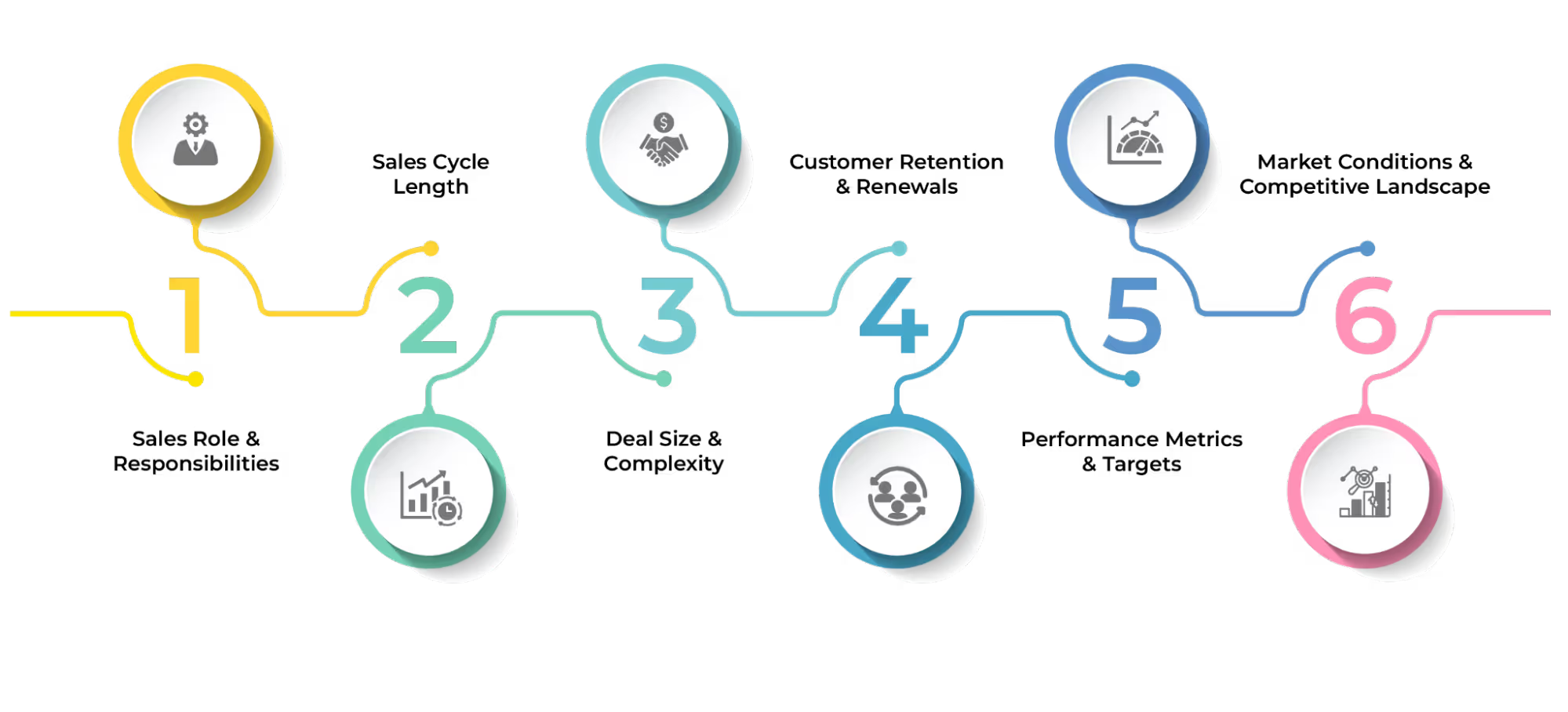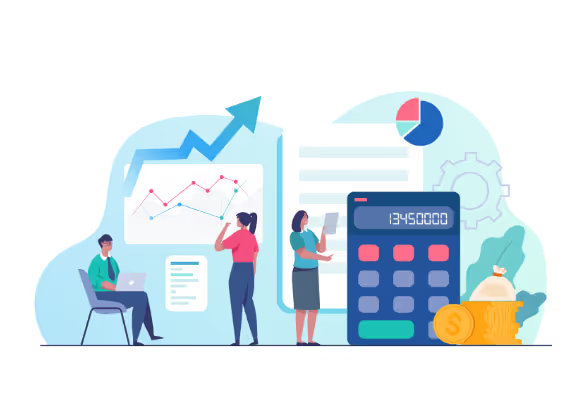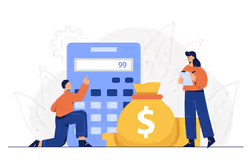
Blog
How to Tackle SaaS Sales Commissions: Designing a Winning Comp Plan
March 14, 2024


Key Insights
It's common knowledge that Software as a Service allows users to access and use their applications after payment. This payment is usually in a subscription format where the user pays at regular intervals to continue using the software or upgrade to access more features.
Hence, SaaS is majorly based on the recurring payment from their customers.
This raises a challenge as to how to design your salesforce commission when the business is subscription-based and has a recurring payment. Is a one-time payment the ideal compensation structure or should their incentive be based on recurring revenue?
This blog answers these queries by helping you understand SaaS sales commission, the various types of SaaS commission, how to design an effective commission structure, and how sales compensation helps stabilize your sales team.
So scroll down for more.
What is a Saas Sales Commission Structure?
A SaaS sales commission structure provides a framework for how the incentive program should be designed for sales reps selling SaaS products or services. Most SaaS companies follow a subscription-based model where customers sign a contract and pay a recurring fee to access the software.
Hence, the SaaS sales commission structure must also be built by considering this recurring nature of the revenue model. In addition, it must also align with the company goals, encourage sales reps to focus on both customer acquisition and retention, as well as foster growth.
Types Of Saas Sales Commission Structures
Choosing the right sales compensation plans for SaaS also depends on their sales goals and unique approach to sales process. Let's explore some of the common types of SaaS commission plans in this approach:

Recurring Revenue Commission
SaaS business usually follows a recurring revenue model. Hence, the sales commission must also be based on the recurring revenue generated from the subscription fees. This means the sales rep's incentive will be calculated as a percentage of the monthly or annual subscription value.
Tiered Commission Rates
Tiered commission rates set sales commissions based on improved sales performance or milestone achievement. This means the SaaS sales commission percentage increases as the sales rep exceeds their expected goals and targets. The tiered commission approach motivates the sales reps to improve their performance and achieve higher milestones.
One-Time Commission
In the one-time commission structure, the sales rep will get paid their commission based on the initial payment. Here irrespective of the recurring revenue the company earns or the subscription-based contract, the sales rep who generated the lead will get paid once in the entire transaction.
Customer Retention Commission
Most SaaS businesses are based on subscription-based use and are heavily reliant on their recurring revenue. Thus, SaaS businesses must focus on customer retention. Their sales reps must be trained, encouraged, motivated, and incentivized to ensure retention.
Cross-Selling and Upselling Commission
SaaS companies are also focused on upselling and cross-selling where they offer enhanced features over the years. Sales reps must be rewarded when they successfully cross-sell or upsell to existing customers. This will help them to explore more areas to enhance the business opportunities and increase customer value.
Performance Bonuses
The regular sales commission rewards the sales rep for achieving their set targets and goals. In addition to this, they must also be incentivized when they show enhanced performance and make exceptional achievements. This includes surpassing their sales targets, acquiring more customers within a time frame, or exceeding their expectations.
These various commission structures can be customized and combined to create a competitive incentive program that boosts sales performance, motivates the salesforce, and ensures the set targets are achieved.
Want to know the difference between sales associate vs sales executive. Check How do Sales Reps and Sales Associates Differ in Skillsets, Responsibilities, and Rewards?

How To Calculate Saas Sales Commission
Saas sales commission calculation can vary depending on various factors including the sales compensation structure, key metrics, and targets that you want to incentivize. Let's look at the basic framework to help understand how typically sales teams go about calculating their SaaS commission.
Determine Commission Structure
The first step to accurately calculating your sales commission is by determining your commission structure. The sales team must determine whether a percentage of sales calculation, a tiered commission structure or a profit-based commission suits their incentive program.
Define Sales Quotas and Targets
The second step is to determine the sales quotas and targets. This helps determine the metrics to be considered, eligibility criteria for commission, and commission rates for easy calculation.
Calculate Commission
Once there is clarity in the commission structure, metrics, and criteria, the sales team will have clarity on the commission calculation. A general formula used for SaaS sales commission calculation is
Commission = (Sales Amount) x (Commission Rate)
For example, a sales rep generated a business of $10,000 in sales revenue. The predetermined commission rate is 10%of the sale. Hence, the commission they get would be $1000.
Consider Additional Factors
Sales commission calculation might not be a one-time process for a particular sale. It can occur that a sale that a sales rep made was followed up for upselling a year later. In such a situation the company will offer incentives to its salesforce. On the other hand, it can so happen that a paid commission can be clawed back when the deal is canceled.
Hence, calculating SaaS sales commissions varies based on business, market, goals and targets, commission structures, incentive policies, and other additional factors. Thus it's important to keep a close track of your calculations, especially considering the diverse sales commission rates by industry, to ensure accuracy and transparency.
Tip: with the new revenue recognition system, sales accounting is changing. If capitalized commission confuses you, then check out Key Steps and Best Practices for Capitalized Commissions under ASC 606.
Check out our free sales commission calculator
Factors that Influence Saas Sales Commission Calculation
Let's look at the additional factors that influence the SaaS commission calculation:

Sales Role and Responsibilities
SaaS commission structure can change according to the sales rep's industry, experience, and responsibilities. For example, the sales commission percentage for a sales rep who is just starting in the SMB industry might be different from a senior sales rep who brings a high sales revenue deal from a large enterprise industry.
Sales Cycle Length
Sales cycle length refers to the duration between the initial contact to the final closing of a deal. A longer sales cycle means consistent effort and regular follow-up from the salesforce to close the deal. While a shorter sales cycle means a strategic performance from the sales rep. Both need to be evaluated based on varying matrics and incentivized based on different parameters.
Deal Size and Complexity
Sales commission automation streamlines the process of factoring in deal size and sales cycle complexity, ensuring that sales representatives are appropriately rewarded with higher commissions and potential bonuses based on these decisive factors.
Customer Retention and Renewals
Salesforce's commission expense includes incentives not only for customer acquisition but also for retaining existing customers and capitalizing on opportunities for cross-selling or upselling new features, particularly in SaaS where pricing is feature-dependent.
Performance Metrics and Targets
Key performance indexes and metrics make the commission calculations objective. These metrics include total revenue generated, customers acquired, churn rate, etc. Sales performance evaluation and determination of incentives based on these metrics provide clarity and transparency to the overall sales commission calculation.
Market Conditions and Competitive Landscape
SaaS sales commission calculations are also susceptible to market conditions and competitiveness. For example, a salesperson working in an industry hard to penetrate will have a higher incentive plan than a sales rep with an easy conversion rate.
Organizations can build a competitive and effective SaaS sales commission by considering these factors and tailoring them based on their business model, organization structure, and salesforce composition.
Food for thought: does incorporating an example of selling concept in marketing improve your sales? Check out the Advantages and Disadvantages of Sales Concepts
What Is The Average Sales Commission For A Saas Account Executive?
According to common industry practices and knowledge, the average SaaS commission rate of an account executive falls in the range of 5% to 15% of the total contract value or annual recurring revenue.
The commission structure is influenced by varying factors like the company, industry, market positioning, pricing model, sales strategy, etc. For example, an account executive who closes a deal in a large enterprise might get a higher commission rate compared to a sales rep in a small business industry.
Sales commission accounting ensures that the compensation earned by high-performing account executives, particularly those excelling within tiered commission structures, accurately reflects their exceptional performance and closing rates, thereby motivating continued success and loyalty within the salesforce.
Account executives who drive sales and revenue and who ensure that their efforts align with the overall financial goal and market competitiveness of the company have a higher chance of earning high commissions and being rewarded for their efforts and performance.
How do Account Managers make Commissions in SaaS Sales?
In SaaS with the possibility of future sales through recurring revenue and upselling, account managers have the opportunity to earn commission beyond the initial deal closing incentive.
Here are a few ways account managers make commissions in SaaS sales.

Renewals
Account managers earn commissions when their customers renew their contracts and subscriptions. Incentivizing this step ensures that they maintain strong relationships with the customers, provide excellent service, and ensure customer satisfaction to drive renewals.
Upselling
Account managers can earn commissions by upselling new features and services to existing customers. This involves identifying existing gaps in the client's operations suggesting new features to overcome these challenges and optimizing the operations through value addition.
Expansion Revenue
Account managers also can earn commissions when customers upgrade their contract or subscription level. This includes adding more users, upgrading to higher plans, or purchasing additional features.
Customer Success
Account managers have a crucial role in ensuring customer success and reducing churn rates. They can incentivize customer satisfaction metrics as they align with the company goal of enhancing customer lifetime value.
Hence, account managers in SaaS incentivize positive behavior that drives customer satisfaction and ensures retention and long-term value. These customer success incentives are in addition to their initial efforts in the sales process.
The combined effort will help ultimately contribute to the overall growth and profitability of the business.
Designing a Saas Sales Compensation Plan that Works
Designing an effective and efficient SaaS sales compensation plan requires taking into consideration various factors. Let us take a step-by-step into these factors that help design a SaaS sales compensation plan that works:

Understand Your Business Model
SaaS business models must clarify their business model. This includes their pricing structure, their subscription plans, and any other additional fees. Clarifying the business models and identifying the revenue streams will help in determining how sales contribute to your revenue and will help in determining the perfect sales compensation plans for SaaS.
Define Clear Sales Objectives
Setting proper sales goals and objectives for your sales team is crucial for an effective sales incentive program. Establishing targets will provide a clear roadmap on what is expected of the salesforce, their set of activities, and objectives to be achieved to be eligible for incentive compensation. In SaaS sales commission this may include customer acquisition and retention, upselling and cross-selling, etc.
Choose the Right Performance Metrics
Objective evaluation of sales performance and determination of sales commission is based on setting key performance metrics. In a SaaS commission structure with recurring revenue and subscription plans the common metrics include Customer Lifetime Value, Churn Rate, Monthly Recurring revenue, etc.
Set Realistic Quotas
Effectiveness of SaaS sales commission is heavily dependent on setting realistic and achievable sales goals. This involves evaluating the historical performance and sales potential of the salesforce, analyzing the market condition and growth potential, and aligning the individual sales goals with the larger company objectives.
Determine Commission Structure
Sales managers must take into consideration the business model to determine their commission structure. Rather than choosing one SaaS commission structure, for effective results, it must be a combination of these multiple commissions that reward salesforce for their performance, customer retention strategy, cross-selling and upselling techniques, etc.
Communicate Clearly
Building a commission structure is just one part of the incentive compensation plan. Communicating how commission is calculated, what are the performance metrics taken into consideration, and what are the eligibility criteria for commissions and bonuses will help salesforce to understand the effect their hard work will bring on their paycheck.
Regularly Review and Adjust
Designing a winning sales plan is not a one-time process. There needs regular review and modification of the sales compensation plan to ensure that it brings the desired results consistently. This modification can be achieved by gathering feedback from the sales force, analyzing their performance, and making adjustments to address the drawbacks and challenges.
Designing a winning and effective sales compensation plan is an ongoing process that needs evaluation and modification depending on the changing goals, objectives, performance, and market.
For further reading, check On Target Earnings (OTE) Model: Unlocking Your Maximum Compensation.
Components to Include in the Compensation Plan Structure
When designing an effective sales compensation plan structure, the sales team must consider factors that ensure achieving company objectives, bring out desired behavior, and recognize people for their efforts.
Let's look at some of these compulsory components to be included while building your compensation plan structure:
Base Salary
Base salary refers to the fixed pay for a sales rep irrespective of the number of sales they make or their performance. It's a fixed amount of money they will receive at the end of the month which brings stability to their personal life. This financial stability helps them focus on their goals and targets even during market fluctuations.
Variable Commission
Variable commission refers to the incentives and commissions that a sales rep receives for their efforts and performance. The variable pay is determined based on various performance indexes like customer acquisition, revenue generation, etc. In addition, it can also be determined based on the compensation structure like percentage of sales, tiered commission, etc.
Bonuses and Incentives
Bonuses and incentives are provided as recognition of the exceptional performance and achievement of the sales reps. This includes closing a deal with a short sales cycle, closing a high revenue deal, surprising the quarterly targets, etc. These recognitions and regards motivate the sales reps to improve their performance and enhance their efforts.
Non-monetary rewards and Recognition
Commission plans can also include non-monetary rewards and recognition. This includes words of public appreciation, opportunities for career development, exclusive privileges, feedback and mentorship from senior leadership, etc. Non-monetary rewards reinforce confidence and morale in sales reps to contribute better towards organizational development.
Your sales commission must be a combination of monetary and non-monetary rewards. Monetary rewards help sales reps work harder towards achieving their set targets and stabilizing their personal life. Non-monetary rewards, on the other hand, create a sense of achievement in them that enhances their engagement and loyalty toward the organization.
At times businesses must go the extra mile where they even offer incentives in the form of non-recoverable draw against commission. These initiatives have a huge effect in bringing the salesforce closer to the organization.
Difficulties in Saas Sales Compensation Plans
Designing a SaaS sales commission can be challenging due to the SaaS business model and sales process. Let's look at some of these difficulties that sales teams must maneuver through:
Recurring Revenue Recognition
SaaS services are mostly subscription-based business models. This means they have recurring revenue during the contract period with opportunities for upselling and cross-selling. In such a complex sales process, determining how to attribute the sales credit and calculate the sales commission becomes a complex process.
Customer Churn and Retention
SaaS companies rely heavily on customer retention rather than customer acquisition. Hence, salesforce compensation must not only be restricted to new sales closing but also take into consideration customer satisfaction and retention that ensure recurring revenue and minimize churn rate.
Multi-Tier Pricing Structures
SaaS companies have immense opportunities for multi-tier pricing and upselling. This means each feature has a different pricing and the customer payment will be a cumulative of all these feature prices. SaaS sales compensation must take into account the relevance of sales reps in facilitating this upselling and enhancing the deal sizes.
Aligning Sales with Customer Success
In SaaS business, sales reps are not just restricted to the sales cycle period and signing of contracts. They play a crucial role in customer success by maintaining strong relationships with the clients, ensuring their satisfaction, and keeping them updated about the new features and long-term value. Hence, a one-time commission process is not an ideal incentive solution in SaaS.
In SaaS business, the profitability of the business is heavily dependent on not just customer acquisition but customer satisfaction and retention. Since sales reps have a crucial role throughout the customer's lifetime, their compensation also must be structured in a way to ensure positive behavior, exceptional customer service, and overall satisfaction.
How Sales Compensation Stabilizes Your Teams
Sales compensation is an inevitable part of effective sales management. A well-defined compensation plan aligns the individual goals with the larger company goals. It acts as a powerful motivational tool that boosts sales performance and enhances business growth.
SaaS commission structure provides a clear roadmap for what is expected from salesforce. It provides clarity on performance expectations, sales quota achievement, and incentive eligibility. In addition, it makes the performance evaluation objective and transparent and ensures that the salesforce is rewarded for their contribution and achievements.
From building healthy competition to promoting collaborative teamwork, an effective sales compensation plan will improve the overall company culture by enhancing employee satisfaction and engagement thereby bringing stability to your sales team.
To read more about sales commissions and incentive compensation programs visit https://www.kennect.io/. For more information on the SaaS Sales Compensation Plan Book A Demo NOW!
ReKennect : Stay ahead of the curve!
Subscribe to our bi-weekly newsletter packed with latest trends and insights on incentives.
Thank you! Your submission has been received!
Oops! Something went wrong while submitting the form.
Your data is in safe hands. Check out our Privacy policy for more info






.avif)
.avif)







